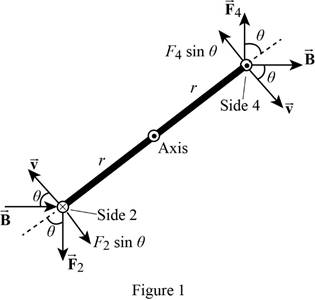
(a)
The magnetic force on side 2 and 4 at the instant shown in Figure 20.7.
(a)
Answer to Problem 64P
The magnetic force on side 2 at the instant shown in Figure 20.7 is
Explanation of Solution
In side 2, current flows into the page and in side 4, current flows out of the page.
Given that the current in the system is,
Write the expression for the magnetic force due to the current carrying loop.
Here,
Use equation (I) in (III).
The direction of the magnetic force is determined using the right-hand rule, and applying right hand rule yields that the magnetic force on side 2 is directed downward and that on side 4 is directed upward.
Conclusion:
Therefore, the magnetic force on side 2 at the instant shown in Figure 20.7 is
(b)
The reason for which the magnetic forces on side 1 and 3 do not cause a torque about the axis of rotation.
(b)
Answer to Problem 64P
The magnetic forces on side 1 and 3 are always parallel to the axis of rotation, and hence they cannot produce a torque about the axis.
Explanation of Solution
If the forces acting on a body is parallel to the axis of rotation of the body, the forces cannot produce a torque on the body. In the given system, the magnetic forces on side 1 and 3 are parallel to the axis of rotation. Hence, they cannot cause a torque about the axis.
Conclusion:
Therefore, the magnetic forces on side 1 and 3 are always parallel to the axis of rotation, and hence they cannot produce a torque about the axis.
(c)
The torque on the loop about its axis of rotation.
(c)
Answer to Problem 64P
The torque on the loop about its axis of rotation is
Explanation of Solution
The diagram depicting the forces on the loop is shown in Figure 1.

Write the expression for the total torque on the loop using the diagram.
Here,
The magnitude of magnetic force
Write the expression for the angular displacement.
Here,
From part (a) the magnetic force is obtained as,
Use equation (VI) and (VII) in(V).
The direction of forces indicates that the torque on the loop is in the counter clockwise direction.
Conclusion:
Therefore, the torque on the loop about its axis of rotation is
(d)
Whether the magnetic torque make the loop increase or decrease its
(d)
Answer to Problem 64P
In the absence of other torques the magnetic torque make the loop decrease its angular velocity.
Explanation of Solution
In the given system, the loop has the angular velocity in the clockwise direction whereas the torque exerted by the magnetic force is obtained as in the counterclockwise direction. Since the direction of magnetic torque is opposite to the direction of the angular velocity, the magnetic torque would tend to decrease the angular speed of the loop.
Conclusion:
Therefore, in the absence of other torques the magnetic torque make the loop decrease its angular velocity.
Want to see more full solutions like this?
Chapter 20 Solutions
Loose Leaf For Physics With Connect 2 Semester Access Card
 College PhysicsPhysicsISBN:9781305952300Author:Raymond A. Serway, Chris VuillePublisher:Cengage Learning
College PhysicsPhysicsISBN:9781305952300Author:Raymond A. Serway, Chris VuillePublisher:Cengage Learning University Physics (14th Edition)PhysicsISBN:9780133969290Author:Hugh D. Young, Roger A. FreedmanPublisher:PEARSON
University Physics (14th Edition)PhysicsISBN:9780133969290Author:Hugh D. Young, Roger A. FreedmanPublisher:PEARSON Introduction To Quantum MechanicsPhysicsISBN:9781107189638Author:Griffiths, David J., Schroeter, Darrell F.Publisher:Cambridge University Press
Introduction To Quantum MechanicsPhysicsISBN:9781107189638Author:Griffiths, David J., Schroeter, Darrell F.Publisher:Cambridge University Press Physics for Scientists and EngineersPhysicsISBN:9781337553278Author:Raymond A. Serway, John W. JewettPublisher:Cengage Learning
Physics for Scientists and EngineersPhysicsISBN:9781337553278Author:Raymond A. Serway, John W. JewettPublisher:Cengage Learning Lecture- Tutorials for Introductory AstronomyPhysicsISBN:9780321820464Author:Edward E. Prather, Tim P. Slater, Jeff P. Adams, Gina BrissendenPublisher:Addison-Wesley
Lecture- Tutorials for Introductory AstronomyPhysicsISBN:9780321820464Author:Edward E. Prather, Tim P. Slater, Jeff P. Adams, Gina BrissendenPublisher:Addison-Wesley College Physics: A Strategic Approach (4th Editio...PhysicsISBN:9780134609034Author:Randall D. Knight (Professor Emeritus), Brian Jones, Stuart FieldPublisher:PEARSON
College Physics: A Strategic Approach (4th Editio...PhysicsISBN:9780134609034Author:Randall D. Knight (Professor Emeritus), Brian Jones, Stuart FieldPublisher:PEARSON





